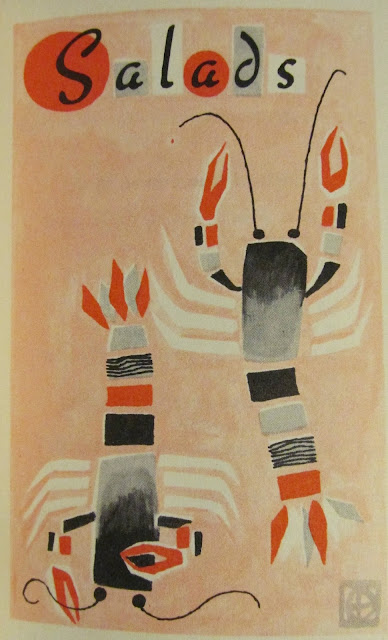Not just any salads. As the lobsters (or crayfish? Whatever they are, they kind of remind me of flamenco dancers for some reason. Becoming a flamenco dancer would be a great strategy for the lobster to stay alive! Why eat a dancing lobster when you could keep it as a pet? Make a tiny dress, maybe get a little fan it can clutch in one claw, charge admission for shows...) from Good Housekeeping's Cook Books "Book of Salads" (1958) suggest, seafood salads.
And since I haven't featured a mold in a while (and I want to make your weekend just a little more scary), I'm featuring seafood salads with gelatin, meant to be served on a bed of nice, crispy greens-- just not the ones I've worked so hard to wash. Get your own!
This first salad might not seem to fit the bill:
It's just a fairly ordinary canned tuna or shrimp salad. But it is supposed to go with "Jellied Cucumber Mold" (which I have to type out by hand because I can't get a good scan or photograph):
Jellied Cucumber Mold
1 env. plus 1/2 teasp. unflavored gelatine [sic]
1/4 cup cold water
1 cup hot water
1/4 cup cider vinegar
2 tablesp. lemon juice
2 to 4 tablesp. granulated sugar
1/2 teasp. salt
2 or 3 drops green food color
1 large cucumber
Mary's Tuna or Shrimp Salad, page 7
Tomato wedges
Add gelatine to cold water; let stand few min.; then add hot water; stir until dissolved. Add vinegar, lemon juice, sugar, salt, and enough food color to make liquid a delicate green. Cool (set in pan of ice water to hasten chilling) until mixture begins to jell.
While mixture is cooling, lightly oil 1-qt. bowl or casserole. Wash and pare cucumber; flute surface by drawing tines of sharp fork down length of it. Cut 12 or 16 thin (1/8" thick), even slices; then dice remainder fairly fine (there should be about 1 cup). Arrange fluted cucumber slices around the sides and outer edge of bottom of casserole. Fold diced cucumber into thickened gelatine; pour carefully into mold; refrigerate until firm.
At serving time: Loosen edges of mold with tip of knife; invert onto cold plate. Arrange tuna or shrimp salad around mold. Garnish with tomato wedges and, if desired, few shrimp arranged on watercress or frilly lettuce.
I will admit to being a bit panicked when the recipe got to the oiling a casserole stage. Were cooks supposed to bake the cucumber first? Luckily, the casserole dish was just supposed to serve as a mold... if diners can consider being expected to eat a pale green, weak-lemonade-with-apple-cider-vinegar-and-cucumber mold alongside some tuna salad lucky.
If a "delicate green" blob doesn't hit your sweet spot for molds, there is always this:
Molded sea-food salad should of course come in the classical fish mold with a creepy olive eye and a sea of lemon twist and lettuce "waves."
The best thing I could say about this cold, jiggly, fishy concoction is that it might bring a special guest to one's dinner table (and maybe it says something about me that I would consider this particular guest to be the "best" thing...)
Happy weekend, everyone! May all your uninvited guests save you from having to clean up afterwards.



I love when the molded seafood salads are shaped into fish :D
ReplyDeleteI'd love to see someone make a lamb aspic and mold it into a lamb cake pan. That would be a new twist on it.
Delete